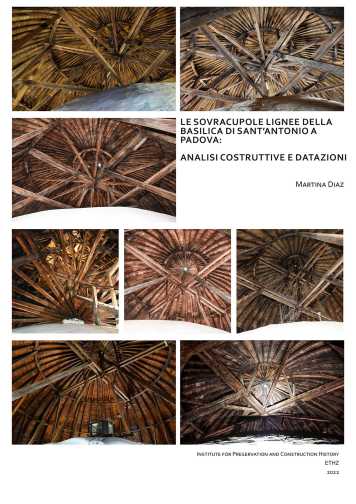M. Diaz: Construction of the domes of the Basilica of St. Anthony in Padua
Dissertation project by Martina Diaz on the subject "The Timber Domes of the Basilica of St. Anthony in Padua: Constructive Analyses and Dating"
Le Sovracupole Lignee Della Basilica Di Sant’antonio A Padova: Analisi Costruttive E Datazioni
Medieval religious buildings turn out to be consistently the most remarkable architectures in terms of technology and size. In the centre of Padua, the Basilica of St. Anthony stretches more than 110 m along the southwest-northeast axis. It characterizes the city skyline with seven domes and a conical superstructure with a height of more than 60 m. The pilgrimage path flows under the two domes on the nave, up to the conical one of the Angel on the crossing. Then the pilgrims turn right under the dome of St James and walk along the ambulatory, around the domes on the Presbytery and Choir. Next, they visit the Saint‘s relics in the domed chapel of the same name at the eastern end of the building. Leaving the ambulatory, they finally reach the St Anthony‘s Ark under the homonymous dome, where the Saint‘s body has been resting for more than seven centuries. The lack of references to the building‘s origin and development afflicted the starting of research. In particular, there is no trace of names of the architects involved in the medieval building site, nor of dates relating to its first construction phase. Even more surprising is the contrast between the massive volume of the brickwork building and the lightness revealed by the wooden frameworks inside the attics. Those who wander through the labyrinth of corridors on the upper level of the Basilica have the privilege of coming across spaces dominated by the brick drums and the wooden domed roofs. The simplicity of their frame and the joints between the wooden elements remind ancient construction techniques. Nevertheless, so far, the history of their restoration, their dating, and the traces of their construction have remained unknown.
The great fire on the 28th of March 1749 is the only well-known historical event of their past. Four of the wooden superstructures burnt. The others survived: the eighteenth-century one on the Relics chapel, the two on the nave and that on the Ark of St. Anthony, which have been assumed to be original. To overcome the deep knowledge gap, research based on scientific grounds tells the story and features of the eight wooden superstructures, aiming to understand their value better. The research covers an extended time from the Middle Ages to the 19th century. The study focuses on the history of the construction and construction techniques of the frameworks. The workflow based on field surveys and the study of indirect sources yielded various data: archival, iconographic, geometric, carpentry, commercial processes, and dating, later evaluated through a cross-referencing approach. The topics include the history and configuration of the domes, the contextualization of the historical timber supply, and the dating activity of the wooden framings. In particular, the latter ones are among the most innovative research outcomes, providing inspiration for further investigation. Eventually, dendrochronology results shed light on the oldest known wooden domes and introduced them to the international context.
The doctoral thesis is part of the SNSF project "The Basilica of St Anthony in Padua: Deciphering the building history of a landmark pilgrimage church"
- Diaz, M.; Holzer, S. M.: The Facade's Dome of St. Anthony's in Padua. Int. Arch. Photogramm. Remote Sens. Spatial Inf. Sci., XLII-2/W11, 481-487. (external page DOI)

